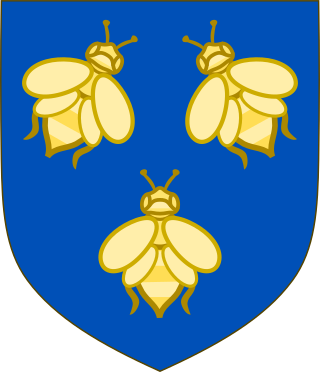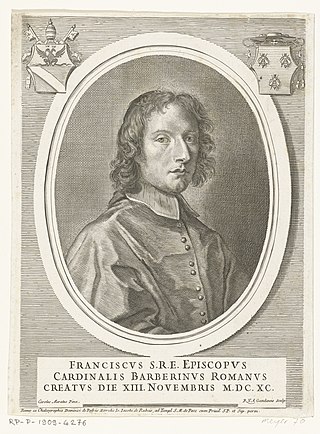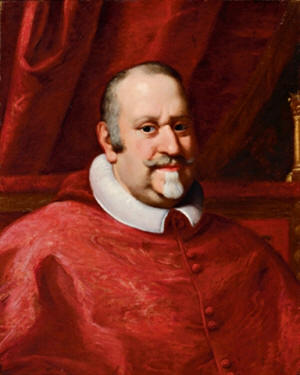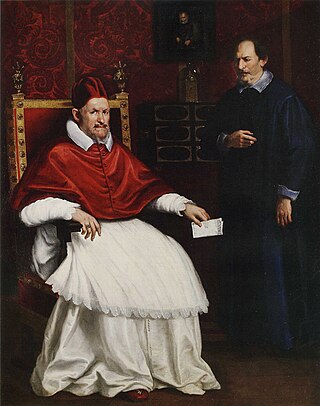
Palestrina is a modern Italian city and comune (municipality) with a population of about 22,000, in Lazio, about 35 kilometres east of Rome. It is connected to the latter by the Via Prenestina. It is built upon the ruins of the ancient city of Praeneste.

The House of Barberini is a family of the Italian nobility that rose to prominence in the 17th century Rome. Their influence peaked with the election of Cardinal Maffeo Barberini to the papal throne in 1623, as Pope Urban VIII. Their urban palace, the Palazzo Barberini, completed in 1633 by Bernini, today houses Italy's Galleria Nazionale d'Arte Antica.

Francesco Barberini was an Italian Catholic Cardinal. The nephew of Pope Urban VIII, he benefited immensely from the nepotism practiced by his uncle. He was given various roles within the Vatican administration but his personal cultural interests, particularly in literature and the arts, meant that he became a highly significant patron. His secretary was the antiquarian Cassiano dal Pozzo who was also a discerning patron of the arts. Francesco was the elder brother of Cardinal Antonio Barberini and Taddeo Barberini who became Prince of Palestrina.

Antonio Barberini was an Italian Catholic cardinal, Archbishop of Reims, military leader, patron of the arts and a prominent member of the House of Barberini. As one of the cardinal-nephews of Pope Urban VIII and a supporter of France, he played a significant role at a number of the papal conclaves of the 17th century. With his brothers Cardinal Francesco Barberini and Taddeo Barberini he helped to shape politics, religion, art and music of 17th century Italy. He is sometimes referred to as Antonio the Younger or Antonio Barberini iuniore to distinguish him from his uncle Antonio Marcello Barberini.

The Diocese of Frascati is a Latin suburbicarian see of the Diocese of Rome and a diocese of the Catholic Church in Italy, based at Frascati, near Rome. The bishop of Frascati is a Cardinal Bishop; from the Latin name of the area, the bishop has also been called Bishop of Tusculum. Tusculum was destroyed in 1191. The bishopric moved from Tusculum to Frascati, a nearby town which is first mentioned in the pontificate of Pope Leo IV. Until 1962, the Cardinal-Bishop was concurrently the diocesan bishop of the see. Pope John XXIII removed the Cardinal Bishops from any actual responsibility in their suburbicarian dioceses and made the title purely honorific.

Taddeo Barberini (1603–1647) was an Italian nobleman of the House of Barberini who became Prince of Palestrina and Gonfalonier of the Church; commander of the Papal Army. He was a nephew of Pope Urban VIII and brother of Cardinals Francesco Barberini and Antonio Barberini. Thanks to their uncle's famous nepotism, the brothers shaped 17th-century Italian politics, religion, art, music and architecture.

Francesco Barberini, iuniore was an Italian Cardinal of the family of Pope Urban VIII (1623–1644) and of the Princes of Palestrina.

Antonio Marcello Barberini, OFMCap was an Italian cardinal and the younger brother of Maffeo Barberini, later Pope Urban VIII. He is sometimes referred to as Antonio the Elder to distinguish him from his nephew Antonio Barberini.

Camillo Francesco Maria Pamphili was an Italian Catholic cardinal and nobleman of the Pamphili family. His name is often spelled with the final long i orthography; Pamphilj.

Lucrezia Barberini was an Italian noblewoman and, by marriage, Duchess of Modena. Born into the Barberini family, she was the last wife of Francesco I d'Este, Duke of Modena.

Anna Colonna (1601–1658) was an Italian noblewoman of the Colonna and Barberini families. She was also the Princess of Paliano.

Maffeo Barberini was an Italian nobleman of the Barberini and Prince of Palestrina. He was appointed Gonfalonier of the Church.

Girolamo Colonna was an Italian Cardinal of the Roman Catholic Church and member of the noble Colonna family.

Carlo Barberini, 1st Duke of Monterotondo, was an Italian nobleman of the Barberini family and lieutenant general of the papal army. He was the brother of Maffeo Barberini, who was elected to the papal throne as Pope Urban VIII.

Urbano Barberini was an Italian nobleman of the House of Barberini, third hereditary Prince of Palestrina and last legitimate male heir of the Barberini line. His great-granduncle was Pope Urban VIII.
Olimpia Giustiniani was an Italian noblewoman of the houses of Giustiniani and Barberini. She was the granddaughter of Olimpia Maidalchini, grand-niece of Pope Innocent X and wife of Maffeo Barberini, Prince of Palestrina.

Pope Innocent X created 40 cardinals in 8 consistories:

Lorenzo Onofrio Colonna (1637–1689) was an Italian nobleman of the Colonna family. He was the 8th Duke and Prince of Paliano and hereditary Grand Constable of the Kingdom of Naples. He was also a Knight of the Golden Fleece.

Angelo Giori was an Italian Catholic Cardinal.

Palazzo Barberini ai Giubbonari, also called Casa Grande Barberini, to distinguish it from the more famous palace in the Trevi district, is a historic palace in Rome. It was the family's first residence in the papal capital and, even after the construction of the palace at the Quattro Fontane, it remained the home of Taddeo, prince of Palestrina, until he fled to France. The palace remained the property of the Barberini family until the fourth decade of the eighteenth century, when they sold it to the Discalced Carmelites, who made it the seat of their General Curia; later passed to the Monte di Pietà, it is now owned by the municipality of Rome and home to educational institutions, including the Vittoria Colonna High School.



















